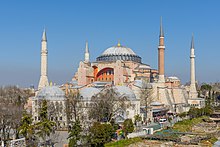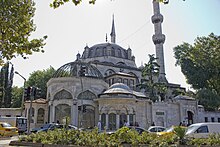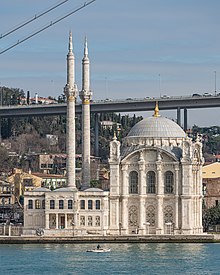
Mehmed III was the sultan of the Ottoman Empire from 1595 until his death in 1603. Mehmed was known for ordering the execution of his brothers and leading the army in the Long Turkish War, during which the Ottoman army was victorious at the decisive Battle of Keresztes. This victory was however undermined by some military losses such as in Győr and Nikopol. He also ordered the successful quelling of the Jelali rebellions. The sultan also communicated with the court of Elizabeth I on the grounds of stronger commercial relations and in the hopes of England to ally with the Ottomans against the Spanish.
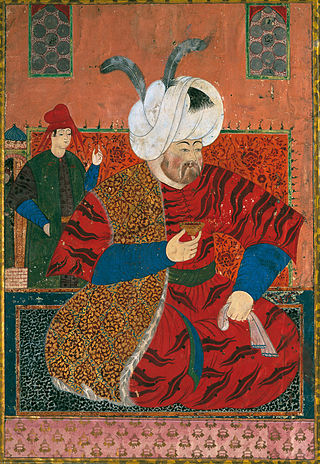
Selim II, also known as Selim the Blond or Selim the Drunkard, was the sultan of the Ottoman Empire from 1566 until his death in 1574. He was a son of Suleiman the Magnificent and his wife Hurrem Sultan. Selim had been an unlikely candidate for the throne until his brother Mehmed died of smallpox, his half-brother Mustafa was strangled to death by the order of his father and his brother Bayezid was killed on the order of his father after a rebellion against him and Selim.

Üsküdar is a municipality and district of Istanbul Province, Turkey. Its area is 35 km2, and its population is 524,452 (2022). It is a large and densely populated district on the Anatolian (Asian) shore of the Bosphorus. It is bordered to the north by Beykoz, to the east by Ümraniye, to the southeast by Ataşehir and to the south by Kadıköy; with Karaköy, Kabataş, Beşiktaş, and the historic Sarayburnu quarter of Fatih facing it on the opposite shore to the west. Üsküdar has been a conservative cultural center of the Anatolian side of Istanbul since Ottoman times with its landmark as well as numerous tiny mosques and dergahs.

Mimar Sinan also known as Koca Mi'mâr Sinân Âğâ, was the chief Ottoman architect, engineer and mathematician for sultans Suleiman the Magnificent, Selim II and Murad III. He was responsible for the construction of more than 300 major structures, including the Selimiye Mosque in Edirne, the Kanuni Sultan Suleiman Bridge in Büyükçekmece, and the Mehmed Paša Sokolović Bridge in Višegrad, as well as other more modest projects such as madrasa's, külliyes, and bridges. His apprentices would later design the Sultan Ahmed Mosque in Istanbul and the Stari Most bridge in Mostar.

Fatih is a municipality and district of Istanbul Province, Turkey. Its area is 15 km2, and its population is 368,227 (2022). It is home to almost all of the provincial authorities but not the courthouse. It encompasses the historical peninsula, coinciding with old Constantinople. In 2009, the district of Eminönü, which had been a separate municipality located at the tip of the peninsula, was once again remerged into Fatih because of its small population. Fatih is bordered by the Golden Horn to the north and the Sea of Marmara to the south, while the Western border is demarked by the Theodosian wall and the east by the Bosphorus Strait.

Nurbanu Sultan was Haseki Sultan of the Ottoman Empire and the legal wife of Sultan Selim II, as the mother of Sultan Murad III and the Valide sultan of the Ottoman Empire from 1574 to till her death in 1583. She was one of the most prominent figures during the time of the Sultanate of Women.

The Fatih Mosque is an Ottoman mosque off Fevzi Paşa Caddesi in the Fatih district of Istanbul, Turkey. The original mosque was constructed between 1463 and 1470 on the site of the Church of the Holy Apostles. Seriously damaged in the 1766 earthquake, it was rebuilt in 1771 to a different design. It is named after the Ottoman sultan Mehmed the Conqueror, known in Turkish as Fatih Sultan Mehmed, who conquered Constantinople in 1453.
Sinan-i Atik, also known as Azadlı Sinan, and Atik Sinan, was an Ottoman architect for Sultan Mehmed II from the empire's Greek community during the 15th century.

Handan Sultan was a consort of Ottoman Sultan Mehmed III, and mother and Valide Sultan to their son Sultan Ahmed I. She acted as de facto ruler during her tenure from 1603 to 1605. Handan Sultan was one of the prominent women during the era known as the Sultanate of Women.

Rüstem Pasha was an Ottoman statesman who served as Grand Vizier to Sultan Süleyman the Magnificent. Rüstem Pasha is also known as Damat Rüstem Pasha as a result of his marriage to the sultan's daughter, Mihrimah Sultan, in 1539. He is regarded as one of the most influential and successful grand viziers of the Ottoman Empire.

The Rum Mehmed Pasha Mosque is an old Ottoman mosque located in a large and densely populated district of Üsküdar, in Istanbul, Turkey.
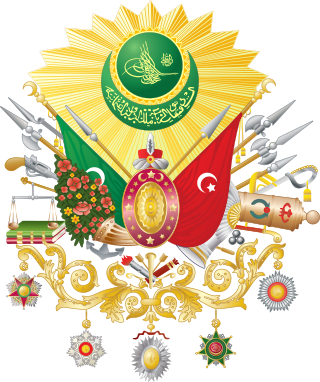
The following outline is provided as an overview of and topical guide to the Ottoman Empire:
The following is a timeline of the history of the town of Istanbul, Turkey.

Rabia Sultan was the Haseki Sultan of Sultan Ahmed II of the Ottoman Empire. She was the last woman to have the Haseki title.
Ayşe Hümaşah Sultan was an Ottoman princess, the only daughter of Mihrimah Sultan and Rüstem Pasha. She was the granddaughter of Sultan Suleiman the Magnificent (1520–1566) and his legal wife Hürrem Sultan.

Classical Ottoman architecture is a period in Ottoman architecture generally including the 16th and 17th centuries. The period is most strongly associated with the works of Mimar Sinan, who was Chief Court Architect under three sultans between 1538 and 1588. The start of the period also coincided with the long reign of Suleiman the Magnificent, which is recognized as the apogee of Ottoman political and cultural development, with extensive patronage in art and architecture by the sultan, his family, and his high-ranking officials.
Davud Agha was the chief imperial architect of the Ottoman Empire from 1588, after the death of his predecessor Sinan, until his death in 1598 or 1599. His works include various monuments from the classical period of Ottoman architecture.

